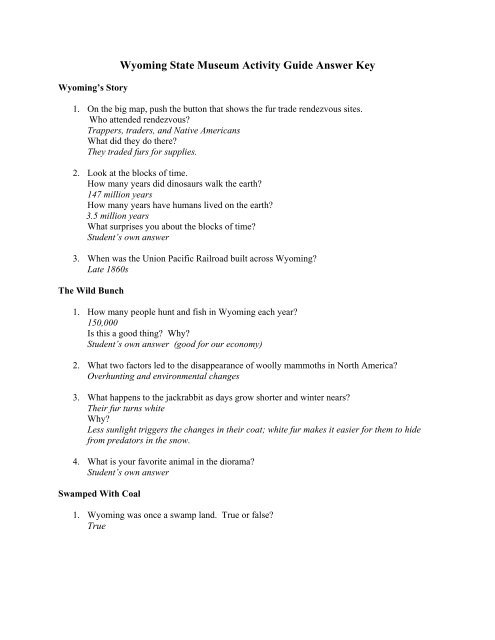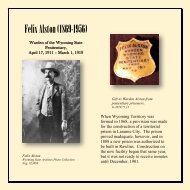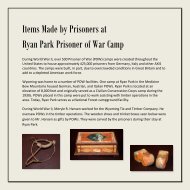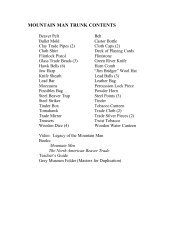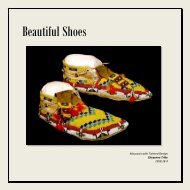Wyoming State Museum Activity Guide Answer Key - the Wyoming ...
Wyoming State Museum Activity Guide Answer Key - the Wyoming ...
Wyoming State Museum Activity Guide Answer Key - the Wyoming ...
Create successful ePaper yourself
Turn your PDF publications into a flip-book with our unique Google optimized e-Paper software.
<strong>Wyoming</strong>’s Story<br />
<strong>Wyoming</strong> <strong>State</strong> <strong>Museum</strong> <strong>Activity</strong> <strong>Guide</strong> <strong>Answer</strong> <strong>Key</strong><br />
1. On <strong>the</strong> big map, push <strong>the</strong> button that shows <strong>the</strong> fur trade rendezvous sites.<br />
Who attended rendezvous?<br />
Trappers, traders, and Native Americans<br />
What did <strong>the</strong>y do <strong>the</strong>re?<br />
They traded furs for supplies.<br />
2. Look at <strong>the</strong> blocks of time.<br />
How many years did dinosaurs walk <strong>the</strong> earth?<br />
147 million years<br />
How many years have humans lived on <strong>the</strong> earth?<br />
3.5 million years<br />
What surprises you about <strong>the</strong> blocks of time?<br />
Student’s own answer<br />
3. When was <strong>the</strong> Union Pacific Railroad built across <strong>Wyoming</strong>?<br />
Late 1860s<br />
The Wild Bunch<br />
1. How many people hunt and fish in <strong>Wyoming</strong> each year?<br />
150,000<br />
Is this a good thing? Why?<br />
Student’s own answer (good for our economy)<br />
2. What two factors led to <strong>the</strong> disappearance of woolly mammoths in North America?<br />
Overhunting and environmental changes<br />
3. What happens to <strong>the</strong> jackrabbit as days grow shorter and winter nears?<br />
Their fur turns white<br />
Why?<br />
Less sunlight triggers <strong>the</strong> changes in <strong>the</strong>ir coat; white fur makes it easier for <strong>the</strong>m to hide<br />
from predators in <strong>the</strong> snow.<br />
4. What is your favorite animal in <strong>the</strong> diorama?<br />
Student’s own answer<br />
Swamped With Coal<br />
1. <strong>Wyoming</strong> was once a swamp land. True or false?<br />
True
2. Why does <strong>Wyoming</strong> have so much coal?<br />
Millions of years ago, swamps covered <strong>Wyoming</strong>. Rotting plants sank into <strong>the</strong> swamps and<br />
were slowly buried by mud. Over time, nature turned <strong>the</strong> buried plants into coal.<br />
3. Who developed <strong>the</strong> first miner’s safety lamp in 1813?<br />
Dr. Reid Clanny<br />
4. What state mines <strong>the</strong> largest amount of uranium?<br />
<strong>Wyoming</strong><br />
Name three things uranium is used for:<br />
Examples include: power plants, x-ray tubes, ultraviolet lamps, glass, ceramics, steel, and<br />
nuclear warheads (until 1965)<br />
Rex In Pieces<br />
1. <strong>Wyoming</strong> is home to one of <strong>the</strong> world’s richest dinosaur fossil beds located between<br />
Medicine Bow and Rock River. What is it called?<br />
Como Bluff<br />
2. What was <strong>the</strong> Apatosaurus mistakenly called for many years?<br />
Brontosaurus<br />
3. Find <strong>the</strong> fossilized freshwater turtle. How old is it?<br />
At least 40 million years old<br />
4. The majority of <strong>the</strong> dinosaur bones that have been found in <strong>Wyoming</strong> have been sent out of<br />
<strong>the</strong> state to be studied and displayed at o<strong>the</strong>r universities and museums.<br />
Do you think that is a good thing? Why or why not?<br />
Student’s own answer.<br />
Barber Gallery<br />
1. Complete <strong>the</strong> sentence.<br />
Washakie is one of <strong>the</strong> few Native American chiefs who never…<br />
Made war against <strong>the</strong> U.S. government<br />
2. Who was Jim Baker?<br />
Baker has been described as a trapper, trader, guide, and Indian fighter.<br />
Would you like to ride in his canoe? Why or why not?<br />
Student’s own answer<br />
3. Which two tribes live on <strong>the</strong> Wind River Indian Reservation in central <strong>Wyoming</strong>?<br />
Shoshone and Arapahoe<br />
4. For how many years have people been making baskets?<br />
For over 10,000 years
Drawn To This Land<br />
1. Name two countries that many <strong>Wyoming</strong> sheepherders came from.<br />
Mexico, Scotland, France, Spain<br />
2. What element did hat makers use on beaver fur that made <strong>the</strong>m “mad as a hatter?”<br />
Mercury<br />
3. Who were <strong>the</strong> Buffalo Soldiers?<br />
The Buffalo Soldiers were two cavalry and four infantry regiments formed in 1866 that were<br />
made up entirely of African American enlisted soldiers (with European American officers).<br />
They served on <strong>the</strong> frontier and were among <strong>the</strong> most reliable regiments in <strong>the</strong> U.S. army.<br />
4. Name one thing you learned in <strong>the</strong> “Trails of Dust, Iron, and Air” exhibit.<br />
Student’s own answer<br />
Living In <strong>Wyoming</strong><br />
1. Why are Japanese kimonos on exhibit in <strong>the</strong> <strong>Wyoming</strong> <strong>State</strong> <strong>Museum</strong>?<br />
They belonged to <strong>the</strong> Suyematsu family, a Japanese family who settled in Casper in 1919.<br />
The Suyematsus established businesses, endured discrimination in WWII, served in <strong>the</strong><br />
military, attended college, and became prominent citizens both locally and nationwide.<br />
2. Why was John A. Campbell an important figure in <strong>Wyoming</strong> history?<br />
John A. Campbell was <strong>Wyoming</strong>’s first territorial governor, and he upheld women’s suffrage.<br />
3. Take a look at <strong>the</strong> kitchen exhibit. Name two things that we can buy in <strong>the</strong> grocery store<br />
today, that people used to make by hand.<br />
Student’s own answer (butter, jelly, juice, milk, waffles, bread, etc.)<br />
Hands-On History<br />
1. Name an object from <strong>the</strong> curiosity cabinet that you have never seen before.<br />
Student’s own answer<br />
2. What animals do you think <strong>the</strong> four pelts in <strong>the</strong> frontier fort came from? Take a guess!<br />
Beaver, coyote, red fox, river otter<br />
3. Find <strong>the</strong> picture on <strong>the</strong> wall that shows women voting. <strong>Wyoming</strong> was <strong>the</strong> first territory and<br />
state to give women <strong>the</strong> right to vote. What year did women in <strong>Wyoming</strong> first vote?<br />
1869<br />
4. What is your favorite item in <strong>the</strong> Hands-on History Room?<br />
Student’s own answer


